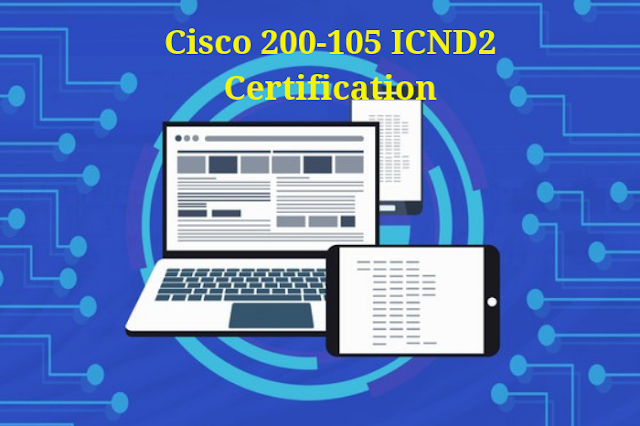There are a lot of reasons why people try to pass the Cisco
200-105 ICND2 certification exam, so that they can achieve something in their
lives in the field of CCNA Routing and Switching certification. Aspiring
applicants need to get through a lot for qualifying for their 200-105 ICND2 certification exam for receiving better jobs in IT in the future.
Becoming Cisco certified is not an easy task. You must
understand the core concept of CCNA Routing and Switching along with many other
things such as interconnecting Cisco networking devices, etc. Only an individual who follows the right approach in preparing for this Cisco ICND2
exam can pass the exam.
Considering this, here we will discuss the essential tips
that will certainly help you pass the exam. You need to assure that you
strictly follow them. Having said that, it is essential to mention that there
are a few things that you must know before acquiring the tips to pass the Cisco200-125 ICND2 exam preparation.
What is the Cisco ICND2 200-125 exam?
Corresponding the Cisco CCNA Certification, the 200-125 ICND2exam means Interconnecting Cisco Networking Devices Part 2. Once you become
Cisco certified, you can get a better job with an excellent pay scale. This
exam is designed to define the expertise level of the applicants in Cisco
networking products. There are other technologies to which this certification
is relevant, such as WAN and LAN switching, IPv4 and IPv6 routing,
infrastructure services and its maintenance, etc.
The ICND2 Exam Details
Here are the raw details of the ICND2 exam:
- Number of Questions: 45-55
- Types of Questions: Multiple Choice (single and multiple answers), Drag-and-Drop, Simulations, Testlets, and Simlets and
- Passing score: It is around 800-850 out of 1000 possible points (Cisco may change this at any time)
- Time Limit: 90 minutes
ICND2 Syllabus Topics:
- LAN Switching Technologies (26%)
- Routing Technologies (29%)
- WAN Technologies (16%)
- Infrastructure Services (14%)
- Infrastructure Maintenance (15%)
There are no precise prerequisites for this Cisco
certification. However, any applicant who register for this exam to become
certified must become familiar with all of the CCNA basics. Whether it is the
diagram or the configuration, you must be confident with all such topics in
each section.
Who can sit for the Cisco ICND2 exam?
Any individual who is aspiring to take this exam must be an
aspiring networking professional or an IT professional with the working
experience in network administration or network engineering. Apart from this,
you also need to have a precise understanding of IT infrastructure services,
infrastructure maintenance, and other technologies such as LAN switching and
WAN routing technologies, etc.
Benefits of the Cisco ICND2 certification exam
Anyone who has thorough knowledge and skills related to the
ICND2 core topics will be able to pass the exam. Once you become CCNA
certified, you are free to look for jobs in the IT industry all around the
globe. You can easily get an excellent job with a higher salary. This
certification assures the hiring managers that you have a thorough knowledge of
various technologies associated with network administration.
These are the most important factors related to the CiscoICND2 certification exam. Now, scroll down to know the tips for passing the
exam.
Tips for passing the Cisco 200-125 ICND2 exam
1. Create a self-study plan for the Cisco 200-125 ICND2 exam
If you want to give any universally recognized tests, then
self-study is of extreme importance. You need to identify that you make a study
plan which you can follow strictly. Take a look at all the ICND2 exam topics
and then spare one day for one topic. You must study all the topics as decided,
and then you will be able to pass this exam. You must make notes while learning
each topic. You must prepare flashcards and point out important points on it.
2. Obtain the best Cisco 200-125 ICND2 Study Guides
Study guides for the Cisco 200-125 INCD2 exam are quite good.
These guides help you a lot in passing the exam with a good score and becoming
Cisco certified. However, it is tough to choose the best self-guides via the
Internet, as there are many options available online. For this reason, you need
to confirm that the study guide you choose comprises all the ICND2 exam topics.
You must also ensure that an expert in Cisco ICND2 certification offers the
guide. You can easily pass the test if you purchase an appropriate guide for
the 200-125 exam.
3. Search for the 200-125 Practice Tests
The more ICND2 practice tests you give, the higher your
chances of passing the exam. But before you lean on any platform for practice
test, you should remember that the Cisco 200-125 ICND2 certification exam is
designed to analyze your understanding of Cisco networking administrator. You
must look out for cost-effective practice tests in the first place. You can quickly
get a discount on these dumps. You must perform as many practice tests as
possible if you want to establish a great career ahead in the IT field.
Conclusion
If you are aspiring to opt for the Cisco CCNA R&S
certification and pass the 200-125 exam, there are a few things that you
must take into account. First of all,
you must have clarity that this certification that fits your profile as an IT
professional. Furthermore, you must assure that you choose the right study
guide and take a lot of practice tests. You should also do the self-study and
try to master all the core concepts related to Cisco 200-125 ICND2 exam.
Furthermore, you must look for the experts’ help that is available via online
forums or communities where all your doubts on any topic could get explained.





